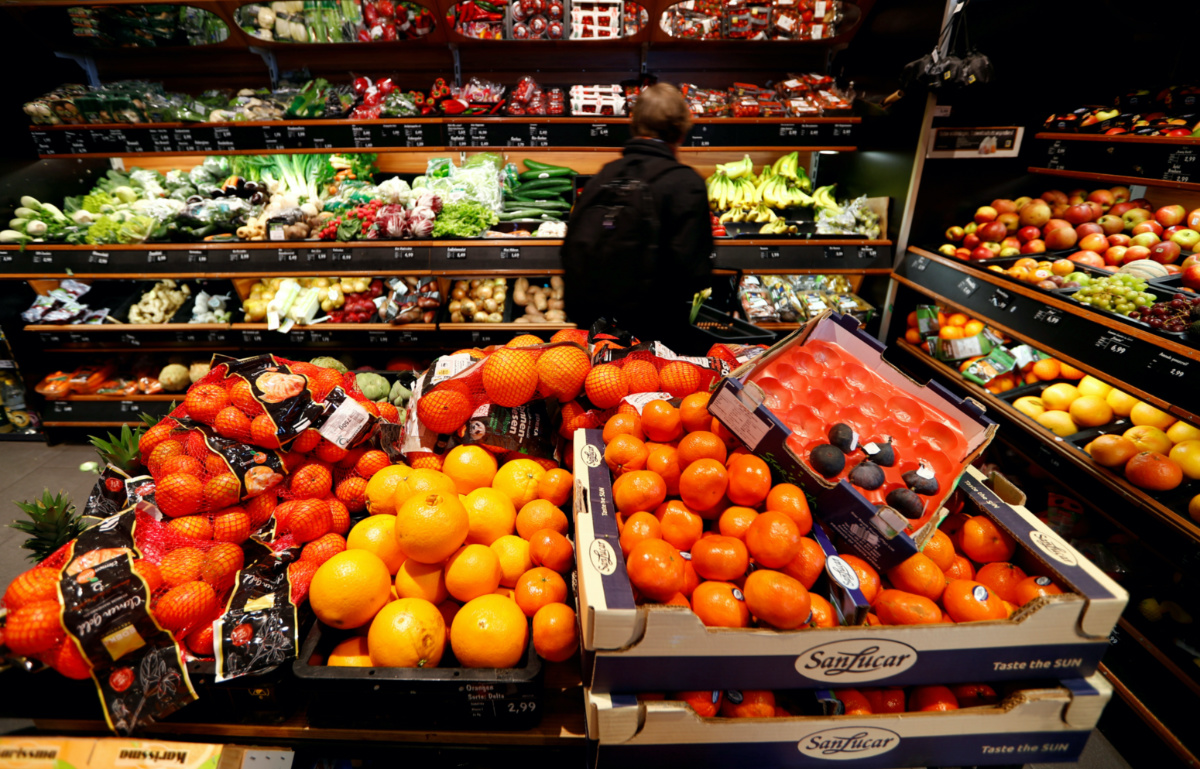London, UK
Reuters
World food prices jumped nearly 13 per cent in March to a new record high as the war in Ukraine caused turmoil in markets for staple grains and edible oils, the UN food agency said on Friday.

Full shelves with fruits are pictured in a supermarket during the spread of the coronavirus disease (COVID-19) in Berlin, Germany, on 17th March, 2020. PICTURE: Reuters/Fabrizio Bensch/File photo.
RUSSIANS’ SPENDING ON FOOD DOUBLES FOLLOWING UKRAINE WAR – UN FOOD AGENCY
Russian citizens are spending on average 40 per cent of their disposable income on food – about twice as much as they did before the Russia-Ukraine war, the director of the UN food agency’s Russia liaison office told Reuters.
Russian government data shows annual food inflation hit 18.75 per cent on 1st April as the economy reels from Western sanctions imposed on Moscow following its 24th February invasion of Ukraine.
Oleg Kobiakov of the UN Food and Agriculture Organisation said many Russian households are now resorting to crisis coping strategies as much of their income goes towards basic needs like food.
“People are postponing plans like going to college or buying a house. They’re saving in case they lose their job, in case of death,” he said.
The average EU household spends about 12 per cent of its income on food, he said, adding that while hunger is not on the cards in Russia, poorer households will face increased levels of food insecurity.
Western sanctions on Russia have closed its economy off from much of global trade, blocked it from swathes of the global financial system and pushed multi-nationals to cut ties with the country.
Many Russians have been panic buying staples like sugar and buckwheat since the war for fear that prices have further to rise, piling pressure on the government to cool inflation.
Moscow is considering regulating prices for food, medicines and other goods and has temporarily banned some agricultural exports. It says it could also move to price almost all its commodity exports in roubles.
While the measures have had some impact in capping consumer inflation, it is still expected to accelerate to 23.7 per cent this year, its highest since 1999, according to a Reuters poll.
The poll also has Russia’s economy shrinking 7.3 per cent in 2022 – in its deepest contraction since 2009.
Kobiakov said Russian salaries have stayed roughly the same since the war, but with prices rising, purchasing power has been eroded and people are worried about job security with many Western firms pulling out of the country.
– MAYTAAL ANGEL/Reuters
The Food and Agriculture Organization’s food price index, which tracks the most globally traded food commodities, averaged 159.3 points last month versus an upwardly revised 141.4 for February.
The February figure was previously put at 140.7, which was a record at the time.
Russia and Ukraine are major exporters of wheat, corn, barley and sunflower oil via the Black Sea, and Moscow’s six-week-old invasion of its neighbour has stalled Ukrainian exports.
The FAO last month said food and feed prices could rise by up to 20 per cent as a result of the conflict in Ukraine, raising the risk of increased malnutrition.
The agency’s cereal price index climbed 17 per cent in March to a record level while its vegetable oil index surged 23%, also registering its highest reading yet, FAO said.
Disruption to supplies of crops from the Black Sea region has exacerbated price rises in food commodities, which were already running at 10-year highs in the FAO’s index before the war in Ukraine due to global harvest issues.
Sugar and dairy prices also rose sharply last month, the FAO said.
In separate cereal supply and demand estimates on Friday, the FAO cut its projection of world wheat production in 2022 to 784 million tonnes, from 790 million last month, as it factored in the possibility that at least 20 per cent of Ukraine’s winter crop area would not be harvested.
The revised global wheat output estimate was nonetheless one per cent above the previous year’s level, it said.
The agency lowered its projection of global cereals trade in the 2021/22 marketing year as increased exports from Argentina, India, the European Union and the United States were expected to only offset some of the disruption to Black Sea exports.
Total cereal trade in 2021/22 was revised down by 14.6 million tonnes from the previous monthly outlook to 469 million tonnes, now two per cent below the 2020/21 level.
Projected world cereal stocks at the end of 2021/22 were revised up by 15 million tonnes to nearly 851 million tonnes, mainly because of expectations that export disruption will lead to bigger stockpiles in Ukraine and Russia, the FAO added.






